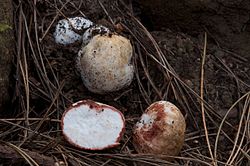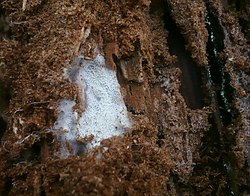Minimum Evolution-Tree Allbatrellaceae 25S-RNA
Evolutionary relationships of Albatrellaceae
Figure. Evolutionary relationships of taxa
The evolutionary history was inferred using the Minimum Evolution method on the (partial) 25S rRNA gene. The optimal tree with the sum of branch length = 0.41327526 is shown. The percentage of replicate trees in which the associated taxa clustered together in the bootstrap test (1000 replicates) are shown next to the branches. The tree is drawn to scale, with branch lengths in the same units as those of the evolutionary distances used to infer the phylogenetic tree. The evolutionary distances were computed using the Maximum Composite Likelihood method and are in the units of the number of base substitutions per site. The ME tree was searched using the Close-Neighbor-Interchange (CNI) algorithm at a search level of 1. The Neighbor-joining algorithm was used to generate the initial tree. The analysis involved 26 nucleotide sequences. All positions with less than 95% site coverage were eliminated. That is, fewer than 5% alignment gaps, missing data, and ambiguous bases were allowed at any position. There were a total of 863 positions in the final dataset. Evolutionary analyses were conducted in MEGA5.
Evolutionary analyses were conducted in MEGA5. Exidia glandulosa strain EL3-99 AF506493 was used as outgroup. All sequences were obtained from the Genbank and were aligned by the CustalW algorithm with standard settings.
List of the GenBank Sequences.
- Albatrellus syringae 25S AF393045
- Albatrellus_avellaneus_isolate_p816L - EU669436
- Albatrellus_avellaneus_isolate_p817L - EU669436
- Albatrellus_caeruleoporus - EU846319
- Albatrellus_confluens - AF506393
- Albatrellus_cristatus - AY293164
- Albatrellus_dispansus_isolate_AFTOL-ID_2000 - EF551312
- Albatrellus_flettii_strain_BG_Thesis - AF518596
- Albatrellus_ovinus - AF506396
- Albatrellus_ovinus - AJ406490
- Albatrellus_pes-caprae - AF506394
- Albatrellus_skamanius - AF393044
- Albatrellus_skamanius_isolate_p863L - EU669303
- Albatrellus_subrubescens - AF506395
- Albatrellus_syringae_isolate_X339 - JN710606
- Amylocystis lapponica strain HHB-13400-sp. - AF518598
- Amylocystis lapponica voucher KHL 11755 (GB) - EU118603
- Amylostereum chailletii - AF506406
- Amylostereum laevigatum - AF506407
- Exidia glandulosa strain EL3-99 - AF506493
- Flaviporus americanus strain HHB 4100-Sp - EU232270
- Heterobasidion annosum AF139949
- Jahnoporus_hirtus_isolate_AFTOL-ID_1687 - DQ911606
- Junghuhnia japonica isolate 10202 - JN710556
- Polyporoletus_sublividus - AF393066
- Polyporoletus_sublividus_voucher_JA030918 - DQ389663
Relevante Bilder
Relevante Artikel
SchafporlingsverwandteDie Schafporlingsverwandten (Albatrellaceae) sind eine Pilzfamilie aus der Ordnung der Täublingsartigen (Russulales). Neben porlingsartigen Gattungen zählen heute auch resupinate und trüffelartige Arten dazu. Die Sporen werden entweder in Röhren oder bei den trüffelartigen in einer Gleba gebildet. Sowohl die Gewebe, als auch die Sporen können amyloid oder inamyloid sein. Sphaerozysten kommen niemals vor. Alle Vertreter sind Ektomycorrhizapilze. Es wird aber vermutet, dass zumindest einige Arten auch fakultativ saprophytisch sind. Die Typusgattung ist Albatrellus Gray (Schafporlinge). .. weiterlesen








